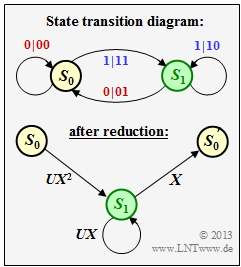Exercise 3.12: Path Weighting Function
In $\text{Exercise 3.6}$ the state transition diagram for the drawn convolutional encoder with properties
- Rate $R = 1/2$,
- memory $m = 1$,
- transfer function matrix $\mathbf{G}(D) = (1, \, D)$
was constructed which is shown on the right.
Now, from this state transition diagram
- the path weighting enumerator function $T(X)$, and
- the extended path weighting enumerator function $T_{\rm enh}(X, \, U)$
can be determined, where $X$ and $U$ are dummy variables. The method is explained in detail in the "Theory part".
Finally, from $T(X)$ the "free distance" $d_{\rm F}$ has to be determined.
Hints:
- This exercise belongs to the chapter "Distance Characteristics and Error Probability Bounds".
- Consider the series expansion in the solution
- $$\frac{1}{1-x} = 1 + x + x^2 + x^3 + \hspace{0.05cm}\text{...}\hspace{0.1cm}.$$
Questions
Solution
(1) From the adjacent graph, one can see that proposed solutions 1, 3, 4, and 5 are correct:
- The state $S_0$ must be split into a start state $S_0$ and a final state ${S_0}'$.
- The reason for this is that for the following calculation of the path weighting enumerator function $T(X, \, U)$ all transitions from $S_0$ to $S_0$ must be excluded.
- Each encoded symbol $x ∈ \{0, \, 1\}$ is represented by $X^x$, where $X$ is a dummy variable with respect to the output sequence: $x = 0 \ \Rightarrow \ X^0 = 1, \ x = 1 \ \Rightarrow \ X^1 = X. $ It further follows
- $$(00) \ \Rightarrow \ 1, \ (01) \ \Rightarrow \ X, \ (10) \ \Rightarrow \ X, \ (11) \ \Rightarrow \ X^2.$$
- For a blue transition in the original diagram $($this represents $u_i = 1)$ add the factor $U$ in the modified diagram.
(2) Correct are the proposed solutions 2 und 3:
- The reduced diagram is a "ring" according to the listing in the "Theory section". It follows:
- $$T_{\rm enh}(X, U) = \frac{A(X, U) \cdot B(X, U)}{1- C(X, U)} \hspace{0.05cm}.$$
- With $A(X, \, U) = UX^2, \ B(X, \, U) = X, \ C(X, \, U) = UX$, one obtains with the given series expansion:
- $$T_{\rm enh}(X, U) = \frac{U \hspace{0.05cm} X^3}{1- U \hspace{0.05cm} X} = U \hspace{0.05cm} X^3 \cdot \left [ 1 + (U \hspace{0.05cm} X) + (U \hspace{0.05cm} X)^2 +\text{...} \hspace{0.10cm} \right ] \hspace{0.05cm}.$$
(3) One gets from the extended path weighting enumerator function to $T(X)$ by setting the formal parameter $U = 1$.
- So both proposed solutions are correct.
(4) The free distance $d_{\rm F}$ can be read from the path weighting enumerator function $T(X)$ as the lowest exponent of the dummy variable $X$ ⇒ $d_{\rm F} \ \underline{= 3}$.

